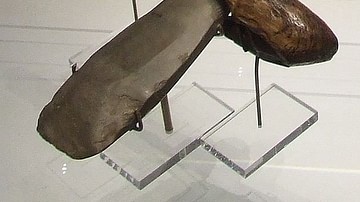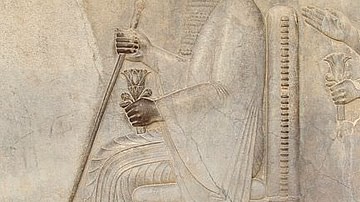Review

| Rating: | |
|---|---|
| Title: | The Archaeology of Iran from the Palaeolithic to the Achaemenid Empire: From the Palaeolithic to the Achaemenid Empire (Routledge World Archaeology) |
| Author: | Roger Matthews & Hassan Fazeli Nashli |
| Audience: | Professional |
| Difficulty: | Medium |
| Publisher: | Routledge |
| Published: | 2022 |
| Pages: | 620 |
The authors focus on human-environment interactions, climate change, societal fragility, and the impact of such interactions on individual and social identities, gender roles, craft specialization, and writing and sealing practices within evolving societal formations. The authors have appealingly reconstructed Iran’s ancient lifeways since the Palaeolithic. The book is an excellent read for academics, students, and enthusiasts in the fields of archaeology and Iranian history
The latest title in the Routledge World Archaeology book series, The Archaeology of Iran from the Palaeolithic to the Achaemenid Empire, provides an analysis of the archaeology and early history of Iran from the Lower and Upper Palaeolithic periods, through the Neolithic, the Chalcolithic, Bronze Age, and Iron Age, to the end of the Achaemenid Empire.
The authors are distinguished academics in the field of Iranian archaeology. Roger Matthews is Professor of Near Eastern Archaeology at the University of Reading, and Hassan Fazeli Nashli is Professor of Archaeology at the University of Tehran. Emphasizing that Iran’s ancient landscapes, climates, and environments are significant in reconstructing past lifeways and their sociopolitical structures, the authors focus on human-environment interactions, climate change, and societal fragility, and the impact of such interactions on individual and social identity, gender roles, craft specialization, and writing and sealing practices within the context of evolving societal formations.
Spanning twelve chapters and richly adorned with maps, photographs, and illustrations with a comprehensive bibliography, this book situates the archaeological evidence from Iran within a framework of issues and debates of current relevance. The authors have drawn heavily on original field reports, archaeological and palaeoclimatic evidence, iconographies, and synthetic studies to study the role of ancient Iran in shaping the modern world.
In Chapters Two and Three, by introducing Iran as a land of "prismatic" diversity in climates, landscapes, and environments, the authors foreground human-environment interactions as critical in the realignment and transformation of attributes of material culture from neighboring communities through all time periods. Chapter Four discusses the role of Iran as a land bridge for early migrations of hominins during the Palaeolithic and Middle Palaeolithic, with its boundaries connecting Asia, the Caucasus, and Europe. However, a pronounced physiography, its extremes of climate, and the shortage of great rivers kept Iranian inhabitants scattered. An analysis of Iran’s Neolithic period in Chapter Five is followed by that of the Chalcolithic period in Chapter Six. It notes the period coinciding with a climatic optimum enabling agricultural surpluses that underpinned the development of complex, state-level societies. A dry period with a collapse of rural settlement is premised to be influential in stimulating transregional social shifts in the Early Bronze Age (3200 BCE to 2100 BCE) including its succession by the Proto-Elamite “state” as a pan-Iranian identity (Chapter Seven). Demonstrated by the Proto-Elamite written corpora, ancient Iran’s writing, a technique of statecraft, with an exclusive elite connection, is also taken to impinge upon the issue of social inequality.
Chapter Eight examines the palaeoclimatic evidence of the Early Transcaucasian Culture (ETC) of Iran in the early 3rd millennium BCE. High levels of precipitation may have caused the migrations. Transregional interactions of the emergent communities of southeastern and northeastern Iran are discussed in Chapter Nine. After the collapse of the ETC in Iran by 2400 BCE as the climate reverted to hotter and drier conditions, many sites were noted to be abandoned by permanent settlements for up to 1,200 years.
The settlement patterns in the Middle-Late Bronze Age (2100 BCE to 1250 BCE) are observed to be patchy until a period of darkness at c. 1100 BC lasting for up to 300 years (Chapter Ten). This episode of transregional disruption is stated to persist through the first phase of the Iron Age, 1250–330 BCE, markedly connected to the increased aridity and cold (Chapter Eleven). From 900 BCE, a recovery in temperature and rainfall levels possibly facilitated a resurgence of settlement and agricultural productivity that enabled the rise of the great states and empires of the mid- and late-Iron Age.
In sum, the authors have appealingly reconstructed Iran’s ancient lifeways since the Palaeolithic. Even with notable evidential blanks, the book is an excellent read for academicians, students of history, and history enthusiasts.
About the Reviewer
Cite This Work
APA Style
Sharma, V. (2023, February 10). The Archaeology of Iran from the Palaeolithic to the Achaemenid Empire. World History Encyclopedia. Retrieved from https://www.worldhistory.org/review/333/the-archaeology-of-iran-from-the-palaeolithic-to-t/
Chicago Style
Sharma, Vineeta. "The Archaeology of Iran from the Palaeolithic to the Achaemenid Empire." World History Encyclopedia. Last modified February 10, 2023. https://www.worldhistory.org/review/333/the-archaeology-of-iran-from-the-palaeolithic-to-t/.
MLA Style
Sharma, Vineeta. "The Archaeology of Iran from the Palaeolithic to the Achaemenid Empire." World History Encyclopedia. World History Encyclopedia, 10 Feb 2023, https://www.worldhistory.org/review/333/the-archaeology-of-iran-from-the-palaeolithic-to-t/. Web. 29 Apr 2025.




